HTC One S Review - International and T-Mobile
by Brian Klug on July 17, 2012 9:30 AM ESTCellular
The HTC One S includes Qualcomm’s MSM8260A SoC, which in turn corresponds to air interface support up to DC-HSPA+ Category 24 (two WCDMA carriers with 64QAM) for a max data rate of 42 Mbps. The difference between this and MSM8960 is obviously the lack of LTE, and lack of CDMA2000 1x/EVDO support which is in MSM8660A (but includes no DC-HSPA+). For T-Mobile, having another DC-HSPA+ phone is an obvious plus, and as we’ll show in a minute results in pretty impressive speeds. The previous DC-HSPA+ platform that T-Mobile deployed was the so-called “SoC Fusion” combination, which consisted of APQ8060 and MDM8220, in devices like the T-Mobile SGS2. International customers, I believe, will get DC-HSPA+ if their carrier has made the correct network and user provisions for it.
For those that aren’t familiar, DC-HSPA+ Category 24 (3GPP Rel.8) employs carrier aggregation in addition to the other HSPA+ features from Release 7. Essentially, two 5 MHz WCDMA carriers are aggregated together on the downlink, resulting in roughly double the performance of a single WCDMA carrier situation. Note that the uplink remains single carrier, so there’s even more of an asymmetry that happens, but given the traffic asymmetry that already exists for most mobile workloads this isn’t a huge deal. When you consider that most LTE deployments in the US are currently at maximum 10 MHz FDD, you can see the roots of T-Mobile’s DC-HSPA+ as “4G” argument. Of course, that is a vast oversimplification, as WCDMA and LTE differ massively in other fundamental ways such as multiplexing scheme (CDMA vs OFDMA) and other features (MIMO, flat IP PS, etc.).
The International and T-Mobile One S differ in what UMTS bands are supported, as the International One S targets both Asia and Europe, while the T-Mobile version goes for the Americas. I’ve made a table with the pertinent information.
| HTC One S - Network Support | |||||
| GSM/EDGE Support | 850 / 900 / 1800 / 1900 MHz | ||||
|
WCDMA Support One S - International |
850 / 900 / 2100 MHz | ||||
|
WCDMA Support One S - T-Mobile |
850 / 1700 / 1900 / 2100 MHz | ||||
| HSPA Speeds | HSDPA 42.2 (Cat.24) / HSUPA 5.76 (Cat.6) | ||||
| Baseband Hardware | Qualcomm MSM8260A | ||||
What’s awesome about the T-Mobile HTC One S is that it supports 2100 MHz UMTS Band I and AWS alongside Cellular 850 MHz and PCS 1900 MHz. The result is that if you either can find one unlocked, or unlock your T-Mobile One S, you get a quad-band phone which supports DC-HSPA+. I managed to get T-Mobile to unlock my One S, and had no issue using it on AT&T. If anything, I wish AT&T would carry a device like this, since I find the smaller form factor very appealing.
The transmit antenna for the One S is at the bottom in the plastic region, and up on the removable part is another diversity receive path.
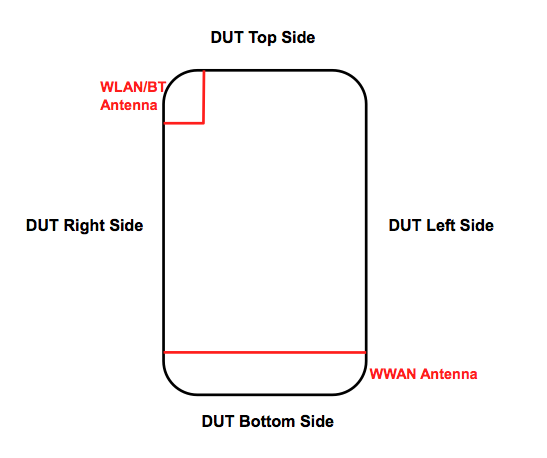
This is our second time showing some DC-HSPA+ results, the first time was in the T-Mobile SGS3. To test, I used the same workflow as always, essentially running as many tests as possible using Ookla’s speedtest.net application on Android, exporting the results, and making some pretty graphs with python.
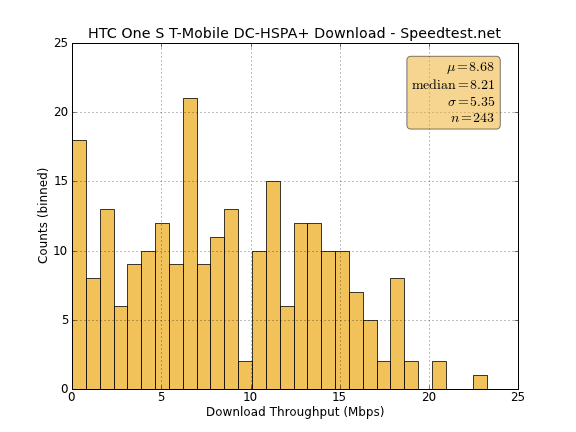
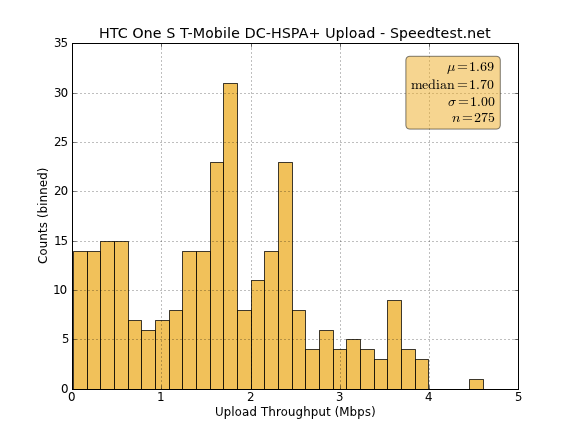
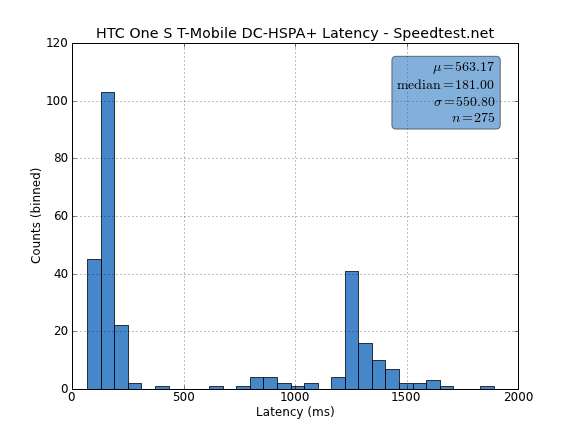
Unsurprisingly DC-HSPA+ is impressively fast on the downlink, with an average of around 9 Mbps and a maximum of just above 20 Mbps. It’s not the kind of performance you’ll get out of LTE (proving that the many subcarrier scheme employed in OFDMA and other enhancements to the physical layer in LTE does in fact pay off), but it’s pretty darn impressive nonetheless. There’s a weird double distribution in latency probably due to setup time coming out of CELL_PCH and setting up the DC-HSPA+ link. Running a test right after this setup yields much lower latency, which is why I say it seems to be connection setup related. I have to say that I’m impressed with how fast T-Mobile’s DC-HSPA+ is in my area, and that DC-HSPA+ isn’t a bad interim air interface until the carrier can deploy LTE. I have a lot of respect for how fast T-Mobile deploys WCDMA related updates.
On the international One S, my only option for testing was AT&T in an 850 MHz market in Pinal County north of me (I'm in Tucson, AZ from Pima county just south, where AT&T is only PCS 1900 MHz). I actually ended up driving over 400 miles and sleeping in a number of different hotel rooms (many Bothans died... and so forth) to finish battery life and speed testing on the International One S because it's the only county in Arizona where AT&T holds an 850 MHz license.
There the phone posted speeds that are more in line with what I expected for single carrier AT&T HSPA+. Running these was more of an exercise in making sure everything was working fine rather than proving something about the One S or AT&T. Those battery life numbers earlier on and seeing what experimental differences come from operating the Rx low noise amplifier in a 10 MHz wide configuration were the real effort. Note that the big power consumer, the Tx power amplifier, which is active when in CELL_DCH and CELL_FACH, is still just 5 MHz because DC-HSPA+ only affects the downlink.
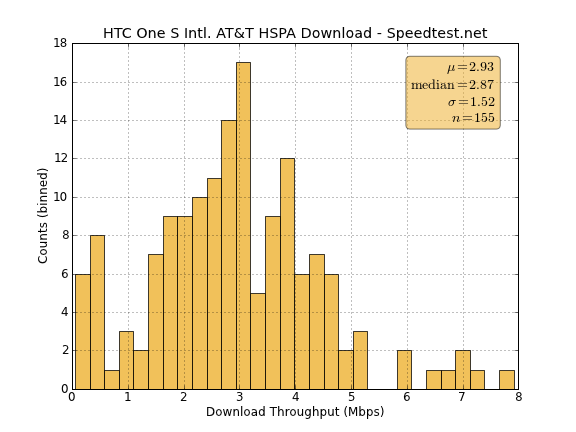

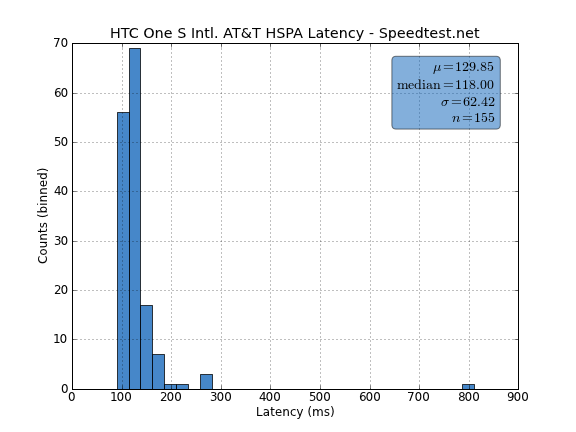
For Qualcomm, the MSM8260A is as much of a stepping stone as the MSM8960, as this is the first time DC-HSPA+ has been integrated into the on-SoC baseband. As I mentioned earlier, the previous solutions were APQ8060+MDM8220 or similar. For T-Mobile, having a number of phones coming up that are compatible with the network’s DC-HSPA+ network is critical to selling its service as being roughly on a similar footing as LTE.
WiFi
Like the HTC One X (AT&T) and XL, the HTC One S uses Qualcomm’s on-SoC baseband for WLAN and BT 4.0. Checking through the boot log, I see the same WCNSS firmware get loaded and initiated which is that WLAN+BT block. The difference between the One X/XL and One S WLAN is that the One S doesn’t include 5 GHz or 40 MHz channel support.
As noted in the above FCC schematic, the WLAN transmit antenna is up at the top in that removable plastic region.
One of our readers pinged me and let me know that reliable iperf ports are now available on Android and iOS, so I’ll be switching over to using iperf for my main WiFi throughput testing instead of the 100 MB PDF. I tested a small number of the phones I’ve got on hand with iperf for comparison.
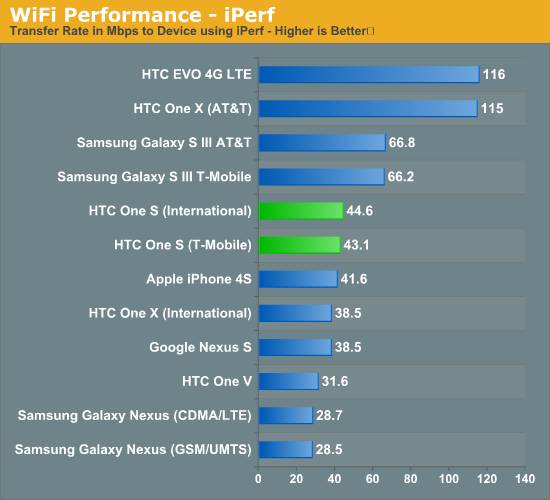
The One X and EVO both have 40HT support on 5 GHz, and thus pull pretty far into the lead. The 20 MHz channel 2.4 GHz devices cluster around 40 Mbps. Unsurprisingly the International and T-Mobile versions are very close.
Speakerphone
I tested speakerphone on the HTC One S using our sound meter 3 inches away from the device on maximum volume. The speakerphone on the One S is underneath the grid of holes on the back at the bottom plastic region. Interestingly enough the devices differed somewhat, though I’d attribute this more to the difference in carrier (AT&T on the International device) than any real difference in loudness between the two.
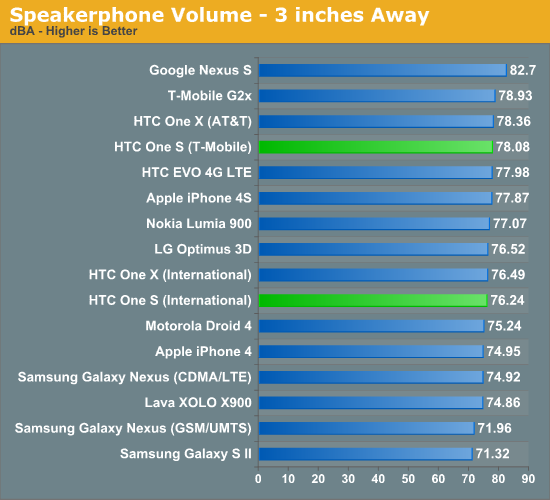
GNSS
I’m starting to sound like a broken record, but just like the One X (AT&T) the One S uses the on-SoC baseband for GNSS (Global Navigation Satellite System). In this case, that means GPS with GLONASS, specifically Qualcomm’s gpsOneGen 8A with GLONASS. I have no problems getting a fast lock even indoors or in an urban environment, and like other combos with GLONASS you can see those satellites pop into use when GPS signal is weak.


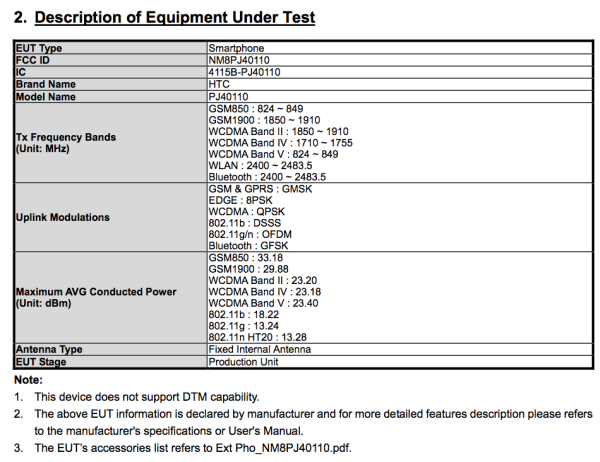
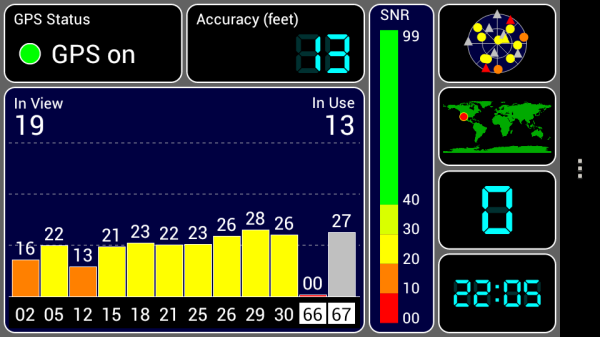








97 Comments
View All Comments
ltcommanderdata - Tuesday, July 17, 2012 - link
To go with the smallest screen size for a modern smartphone, the iPhone 4S also has the smallest battery as shown on the first chart on page 2. It'd be interesting o find out how display power consumption scales with screen size to see if they are scaling battery size fast enough to fully compensate, but big phones with big screens do tend to have big batteries so big screens shouldn't automatically mean bad battery life.Penti - Tuesday, July 17, 2012 - link
4S doesn't have HSPA+ baseband only 14.0 Cat 10 HSDPA. I.e. 14Mbit "4G-branding". In short small batteries, large screens, fast processors and gpus and power hungry baseband is what drains these devices. You need a significant larger battery to have a better battery life here. For most devices that isn't a priority. For example the iPad 3 gen has a larger battery then MBAir 11.amdwilliam1985 - Tuesday, July 17, 2012 - link
Please explain the 4G part to a friend of mine.She claims her 4G iPhone 4s with iOS 5.1.1 on AT&T network can't go through a day with moderate usage.
Penti - Tuesday, July 17, 2012 - link
What, it's just a 3G WCDMA baseband, no other radio or tech it shouldn't draw more power just because the icon says 4G in this 3.75G device. No smartphone survives more then a day with moderate usage, calls and what not. An 4s is spec'd at 8 hours talk time and 6 hours of internet use over 3G respectively. Play a game and the device is pretty much dead half day. Using apps that pull data over the wireless cellular network, talk for a few hours and play a game for 15 minutes and it should be pretty drained. If there is nothing wrong with the device then it is the usage that has to change to accommodate more battery life. If you need to talk for hours a day and be connected to chat, surf the web, use apps that leverage the internet and all that over the network you would need some solution to charge the phone over the day not matter what device you run.Why some people whine about early LTE phones is because they had bad dual baseband chips and about half the talk time. Pretty bad battery life surfing on LTE etc.
Spoelie - Tuesday, July 17, 2012 - link
I'm wondering if the battery tests have ever been redone following iOS updates. In my experience, the battery life gets progressively worse with every new update. In this case, doing the tests once on release day and reusing the numbers for months on end may not be the best approach.Anand Lal Shimpi - Tuesday, July 17, 2012 - link
I'll take the blame for this one. Notice the revamp of our tablet and OS X battery life tests? The smartphone web browsing test is in need of an update there as well. iOS has gotten a little too "good" at what we're doing there, at least in the web browsing test. The call and tethering tests are still great cross-platform indications of battery life.rd_nest - Tuesday, July 17, 2012 - link
I think we should also look at multimedia playback times. Run high profile video files to check battery rundown time. It's an important parameter as far mobile usage is concerned.The SGS3 (International) is getting pretty good numbers compared to US SGS3 models.
yvizel - Tuesday, July 17, 2012 - link
Saying 3.5'' vs. 4.3'' is not an accurate argument.If you come to think of it, the iphone is a smaller device, therefore packs a smaller battery (as you can see in the Battery Capacity chart).
Also, I would rather have a "slower" processor and more battery juice than have an octa-core @ 4GHz on a smartphone with 1 hour of usage!
Not all of us use smartphone for gaming or whatever. I guess that the more common usage is web, email, GPS and other basic stuff. So again, no need for zillion cores on a smartphone.
Oh, and great review! looks like a great device!
Connoisseur - Tuesday, July 17, 2012 - link
My point is that it's extremely difficult to compare phones of different size, resolution, screen type, OS and capacity. Even if you remove the OS out of the mix (so you can compare OS "efficiency"), the only comparison you can really make between two different devices is hours/battery capacity efficiency.At least when comparing laptops, you have some basis for comparison (comparable hardware or form factor for example).
amdwilliam1985 - Tuesday, July 17, 2012 - link
We can do the following 2 tests.1) Hack and put iOS on an Android device and run the same test against iPhone 4s.
2) Hack both device and put a custom OS on both and run the test.
This way we can see if it's software or hardware that's affecting the battery life.